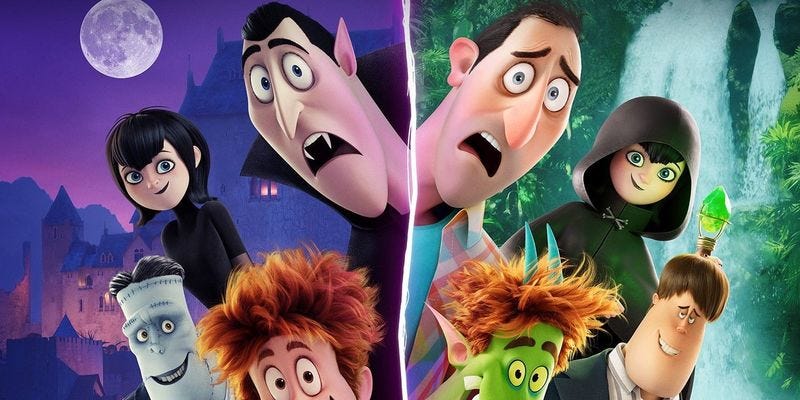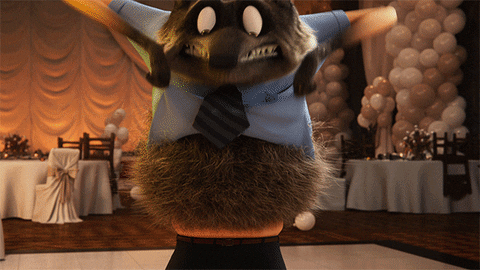Hotel Transylvania: Transformania | Film Review
" “>

Despite the growing recognition in the West that animation is not a medium made expressly for children, there is an expansive industry that revolves around productions that aim specifically for that audience. Ahem… Disney? Heard of ‘em? There are a number of outfits that play in that space these days. Warner, Illumination, Pixar, DreamWorks, Universal, and Sony Pictures Animation, in no particular order, are a smattering. Each studio has their own “voice” but Sony’s Hotel Transylvania franchise is a series of films that speaks in its own voice, and that voice is Genndy Tartakovsky.
And yet, Tartakovsky’s participation in the fourth entry in the tetralogy is limited to writing the story, co-penning the script, and acting as an executive producer. Instead, the helm was handed off to co-directors Derek Drymon and Jennifer Kluska, who are both first timers in the director’s chair (that’s a big chair.) Tartakovsky wasn’t the only one to decline participation in this latest, and reportedly final, installment, either. Most notably, Adam Sandler was replaced by Brian Hull as the voice of Count Dracula and Kevin James’ Frankenstein was replaced by Brad Abrell. Trust me when I say that you won’t miss them. The replacements are almost exact matches, indicating that star power just isn’t necessary to support feature-length animation. All it does it foster bloated production costs.
Sony describes Hotel Transylvania: Transformania as follows:
When Van Helsing’s mysterious invention, the “Monsterfication Ray”, goes haywire, Drac and his monster pals are all transformed into humans, and Johnny becomes a monster. In their new mismatched bodies, Drac, stripped of his powers, and an exuberant Johnny, loving life as a monster, must team up and race across the globe to find a cure before it’s too late, and before they drive each other crazy. With help from Mavis and the hilariously human Drac Pack, the heat is on to find a way to switch themselves back before their transformations become permanent. [SOURCE: IMDB.com]
At its core, Hotel Transylvaniais both an homage to classic luminaries of the Golden Age of animated shorts like Wily Coyote, Tom & Jerry, Popeye the Sailorman, and even more contemporary adherents to classic animated hijinks like Roger Rabbit and Ed, Edd, & Eddy (a meta turducken, if you will) and entirely its own thing, something like Rush is to rock music or Ben Folds Five is to alternative.
Nuts & Bolts
As the fourth entry, HT4 is a solid evolution of the defined art style, but it doesn’t stray from the franchises established parameters. This is no Spider-Verse and yet the color palette is rich and bright, lighting and luminance effects are excellent, and the correct application of bokeh and the lens effects bring believable depth to most scenes. It’s clear, that Sony has been working hard to refine their process. That said, some of the textures don’t look great (the rock slide in the opening musical number looks like crap) which is a big oversight on such a high-visibility production.
Character designs, on the other hand, are peak franchise, hewing closely to the immutable nature of classic cartoon character design that said characters are iconic and must remain recognizable. They only change in service of a gag and always return to their pristine base form when the gag is complete. This is the same basic rule that defines all character designs from all cartoon where these icons always wear the same clothes, et al. Imagine Fred Flintstone wearing actual pants or Jessica Rabbit wearing something other than her signature red, sequined dress… oh. Well, not that, but you get the idea. Thanks, Disney Whitewashing Division…
The story telling is solid, if a bit on the basic side, something I’d expect of Illumination’s work. It’s not bad, but it’s also not sophisticated. The comedy revolves almost entirely around the physical gags which, in turn, defines the entire film. In a film that is more a buddy adventure flick, ala the far superior Emperor’s New Groove, then another entry in the HT canon it works to a degree, but not entirely. There’s little to no meta humor that pleases both adults and kids alike, depending on your depth of knowledge. It comes down to the gag, and that gag is always a physical comedy bit. The approach takes away from the core conceit; two people coming to terms with each other by walking in each others shoes.
 Unexpected hair loss syndrome…
Unexpected hair loss syndrome…If anything jumps out at me it’s that the film feels claustrophobic. We start in Drac’s house, then the hotel, the plane, the provincial town, the bus, the jungle, and the cave, then back to the hotel. While the story is about Johnny and Drac and their journey towards acceptance of their differences, and spending time in each others shoes, it pulls back from the more expansive world-building as exemplified in the Tartakovsky-helmed entries. Since each scene needs to serve the setup for the next visual gag, any potential avenues for additional, foundational scope and scale is ditched in favor of setting up for the next gag.
And that’s where it lies; at the intersection of storytelling and spectacle, with the visuals winning over the written by a long shot. It’s not a terrible movie, to be sure, but you won’t derive much but the most deconstructed joy, the kind that makes a little kid roll around in the dirt with the giggles but generally doesn’t survive the transition to higher modes of cognition that come with age.
It should be a hit for years to come as a go-to for quiet toddler mommy hours worldwide.